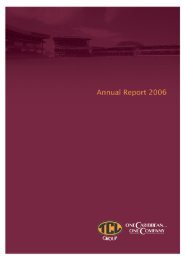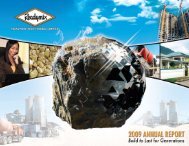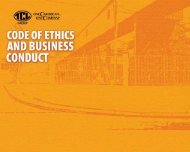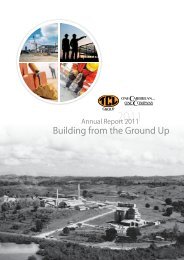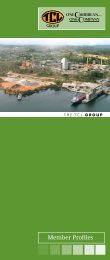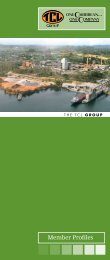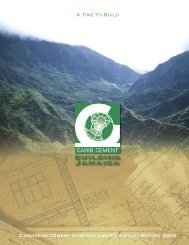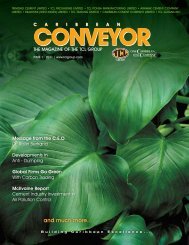Download File - TCL Group
Download File - TCL Group
Download File - TCL Group
You also want an ePaper? Increase the reach of your titles
YUMPU automatically turns print PDFs into web optimized ePapers that Google loves.
NOTES TO THE CONSOLIDATED FINANCIAL STATEMENTS<br />
FOR THE YEAR ENDED 31ST DECEMBER, 2010<br />
(Expressed in Thousands of Trinidad and Tobago Dollars, except where otherwise stated)<br />
(Continued)<br />
2. Significant accounting policies (continued)<br />
h) Taxation<br />
Current income tax<br />
Current income tax assets and liabilities for the current and prior periods are measured at the amount expected to be recovered from<br />
or paid to the taxation authorities. The tax rates and tax laws used to compute the amount are those that are enacted or substantively<br />
enacted by the reporting date.<br />
Deferred income tax<br />
A deferred tax charge is provided, using the liability method, on all temporary differences between the tax bases of assets and<br />
liabilities and their carrying amounts for financial reporting purposes.<br />
Deferred tax assets are recognized for all deductible temporary differences, carry–forward of unused tax credits and unused tax losses,<br />
to the extent that it is probable that future taxable profit will be available against which these deductible temporary differences, and<br />
carry-forward of unused tax credits and tax losses can be utilised. The carrying amount of deferred tax assets is reviewed at each<br />
reporting date and reduced to the extent that it is no longer probable that sufficient future taxable profit will be available to allow all<br />
or part of the deferred tax assets to be utilised.<br />
i) Employee benefits<br />
The parent company employees are members of the Trinidad Cement Limited Employee’s pension plan, while Premix & Precast<br />
Concrete Incorporated’s employees are members of the Arawak Cement Limited Employee’s pension plan. The pension plans are<br />
generally funded by payments from employees and by the relevant <strong>Group</strong> companies, taking account of the rules of the pension plans<br />
and recommendations of independent qualified actuaries.<br />
The <strong>Group</strong> accounts for this defined benefit plan using the projected unit credit method. Under this method, the cost of providing<br />
pensions is charged to the consolidated income statement so as to spread the regular cost over the service lives of the employees<br />
in accordance with the advice of independent actuaries who carry out a full valuation every three years. The pension obligation<br />
is measured at the present value of the estimated future cash outflows using interest rates of long term government securities. All<br />
actuarial gains and losses are spread forward over the average remaining service lives of employees.<br />
j) Financial instruments<br />
Financial instruments carried on the statement of financial position include cash and bank balances including advances/overdrafts,<br />
accounts payables, accounts receivables and borrowings. The particular recognition methods adopted are disclosed in the individual<br />
policy statements associated with each items.<br />
k) Cash and cash equivalents<br />
For the purpose of the statement of cash flows, cash and cash equivalents include all cash and bank balances and overdraft balances<br />
with maturities of less than three months from date of establishment.<br />
l) Revenue recognition<br />
Revenue is recognised to the extent that it is probable that the economic benefits will flow to the <strong>Group</strong> and the revenue can be reliably<br />
measured. Revenue is measured at the fair value of the consideration received, excluding discounts, rebates and sales taxes. The<br />
following specific recognition criteria must be met before revenue is recognised:<br />
Sales of concrete and other materials<br />
Revenue from the sale of concrete and other materials is recognised when the significant risks and rewards of ownership of the goods<br />
have passed to the buyer, usually on delivery of the goods.<br />
Interest income<br />
Interest income is recognized as interest accrues.<br />
21<br />
BUILD TO LAST FOR GENERATIONS



